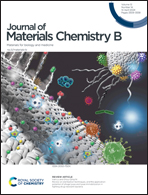Shedding light on ONOO− detection: the emergence of a fast-response fluorescent probe for biological systems†
Abstract
ONOO−, a bioactive molecule, plays a critical role in inflammation-related signaling pathways and pathological mechanisms. Numerous studies have established a direct correlation between elevated ONOO− levels and tumor progression. Therefore, investigating ONOO− levels in inflammation and tumors is of utmost importance. Fluorescence imaging presents a highly sensitive, non-invasive, easily operable, selective, and efficient method for ONOO− detection in situ. In this study, we designed and synthesized a rhodamine-based probe, NRho, which effectively identifies tumors, inflammatory cells, tissues, and organs by detecting ONOO− content. The synthesis process of NRho is simple, yielding a probe with favorable spectral characteristics and rapid response. Our cell imaging analysis has provided novel insights, revealing distinct ONOO− levels among different types of cancer cells, with hepatocellular carcinoma cells exhibiting higher ONOO− content than the others. This observation marks the proposal of such variations in ONOO− levels across cancer cell types. Furthermore, our study has showcased the practicality of our probe in live organ imaging, enabling the identification of tumors from living organs within a brief 5-minute incubation period. Additionally, our findings highlight the rapid detection capability of the probe NRho in various tissue samples, effectively identifying inflammation. This research holds important promise in advancing biomedical research and clinical diagnosis.



 Please wait while we load your content...
Please wait while we load your content...